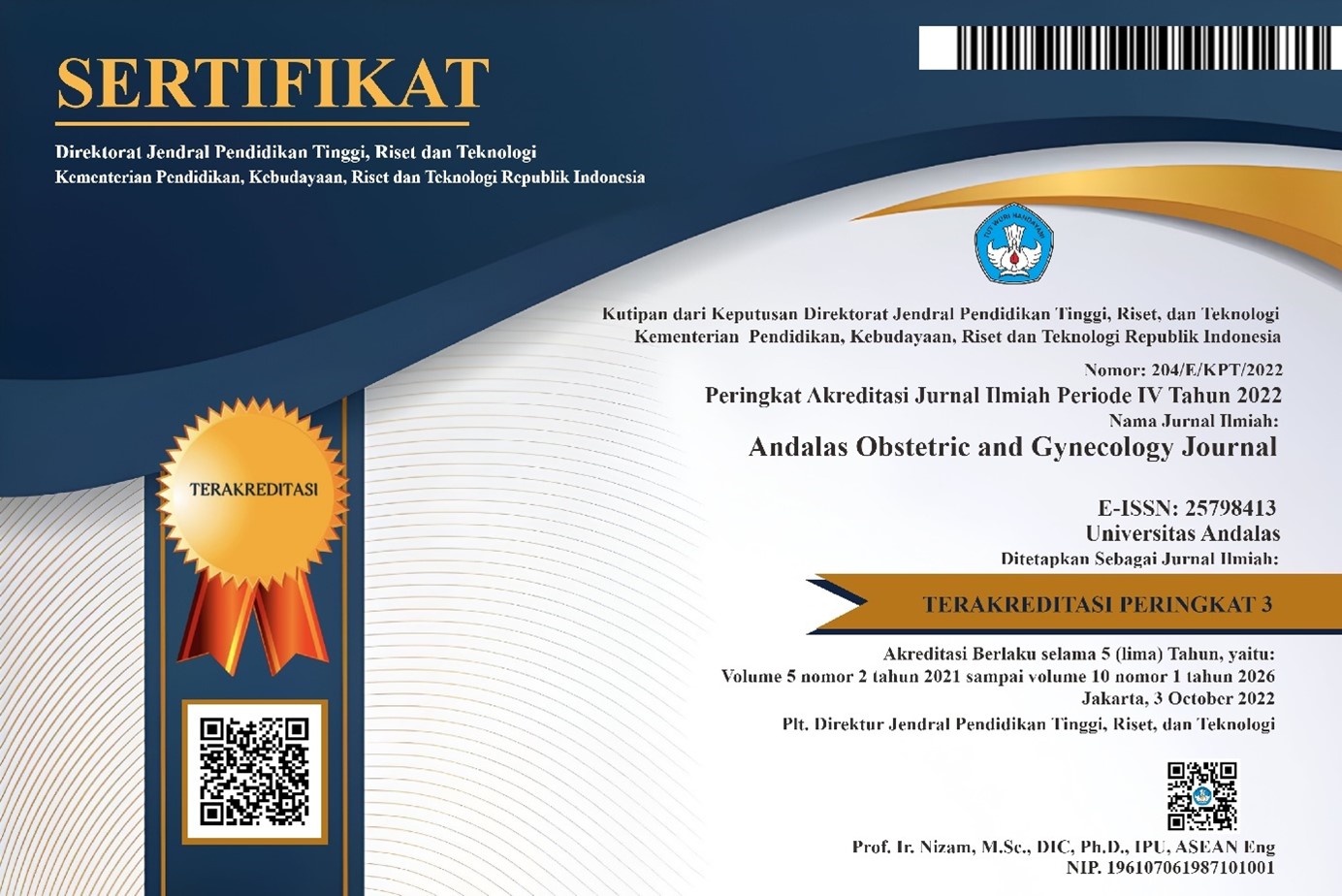Myxoid ovaries that resemble malignancy in young girls: a case report
DOI:
https://doi.org/10.25077/aoj.7.2.473-478.2023Keywords:
Ovarian myxoma, benign ovarian tumor, young ageAbstract
In the most recent publications on Mayer-Rokitansky-Küster-Hauser (MRKH) Myxoma is a benign tumor that generally occurs in the heart, soft tissue, muscle, skin and bone. But in this case, we present myxoma that occurs primarily in the ovary. Ovarian myxsoma is a rare benign tumor.
In this case report, it was found that a 12-year-old girl was brought by her parents to the M. Djamil Hospital in the city of Padang, West Sumatra. After performing the gynecological physical examination and ultrasonography, there was a hypoechoic mass with an indeterminate solid part of the right adnexa, which was suspected of being an ovarian malignancy. Then it was decided to carry out a procedure in the form of a conservative surgical staging laparotomy. The results of the Anatomical Pathology examination confirmed the myxoid ovarian appearance and the patient was decided for regular monitoring.Â
References
Shaib WL, Assi R, Shamseddine A, Alese OB, et. al. Appendiceal Mucinous Neoplasms: Diagnosis and Management. The Oncologist. 2017;22:1107-16.
H.H. Gonzalez, K. Herard, M.C. Mijares, A rare case of low-grade appendiceal mucinous neoplasm: a case report. Cureus. 2019;11 (1):e3980.
E. Kalu, C. Croucher, Appendiceal mucocele: a rare differential diagnosis of
acystic right adnexal mass, Arch. Gynecol. Obstet. 2015; 271 (1):86–88.
Mittal R, Chandramohan A, Moran B. Pseudomyxoma peritonei: natural
history and treatment. Int J Hyperther. 2017;33:511-519.
Bevan KE, Mohamed F, Moran BJ. Pseudomyxoma peritonei. World J
Gastrointest Oncol. 2016;2:44-50.
Kostov S, Kornovski Y, Slavchev S, Ivanova Y, et. al. Pseudomyxoma peritonei of appendiceal origin mimicking ovarian cancer – a case report with literature review. Menopause Rev. 2021;20 (3):148-153.
Chen W, Ye JW, Tan XP, Peng X, et. al. A case report of appendix mucinous adenocarcinoma that recurred after additional surgery and a brief literature review. BMC Surgery. 2020;20:e182.
Aleter A, Ansari WE. Incidental appendiceal mucinous neoplasm mimicking a left adnexalmass: A case report. International Journal of Surgery Case Reports. 2020;74:132–135
Carr NJ, Cecil TD, Mohamed F, et al. A consensus for classification and pathologic reporting of pseudomyxoma peritonei and associated appendiceal neoplasia. Am J Surg Pathol. 2016;40:14-26.
Shih IM, Yan H, Speyrer D, Shmookler BM, Sugarbaker PH, Ronnett BM. Molecular genetic analysis of appendiceal mucinous adenomas in identical twins, including one with pseudomyxoma peritonei. Am J Surg Pathol. 2018;25:1095-1099.
Bignell M, Carr NJ, Mohamed F. Pathophysiology and classification of pseudomyxoma peritonei. Pleura Peritoneum. 2016;1:3-13.
Figueiredo GB, Bechara G.R, Marquesi DG, Jarske RD, Borges CF. Mucinous adenocarcinoma of the appendix invading the urinary bladder. Urology Case Reports. 2020;31:101193
W.L. Shaib, R. Assi, A. Shamseddine, et al. Appendiceal mucinous neoplasms:diagnosis and management. Oncologist. 2017;22 (9):1107–1116.
Downloads
Published
Issue
Section
License
Copyright (c) 2023 Fajriman -

This work is licensed under a Creative Commons Attribution 4.0 International License.
Copyright
Authors who publish with this journal agree to the following terms:
- Authors retain the copyright of published articles and grant the journal right of first publication with the work simultaneously licensed under a Creative Commons Attribution 4.0 International License that allows others to share the work with an acknowledgment of the work's authorship and initial publication in this journal.
- Authors are able to enter into separate, additional contractual arrangements for the non-exclusive distribution of the journal's published version of the work (e.g., post it to an institutional repository or publish it in a book), with an acknowledgment of its initial publication in this journal.
- Authors are permitted and encouraged to post their work online (e.g., in institutional repositories or on their website) prior to and during the submission process, as it can lead to productive exchanges, as well as earlier and greater citation of published work (See The Effect of Open Access).
License:
Andalas Obstetrics and Gynecology Journal (AOJ) is published under the terms of the Creative Commons Attribution 4.0 International License. This license permits anyone to copy and redistribute this material in any form or format, compose, modify, and make derivatives of this material for any purpose, including commercial purposes, as long as they credit the author for the original work.







